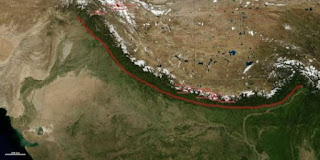Nepal earthquake: Waiting for the complete rupture

In April 2015, Nepal -- and especially the region around the capital city, Kathmandu -- was struck by a powerful tremor. An earthquake with a magnitude of 7.8 destroyed entire villages, traffic routes and cultural monuments, with a death toll of some 9,000. However, the country may still face the threat of much stronger earthquakes with a magnitude of 8 or more. This is the conclusion reached by a group of earth scientists from ETH Zurich based on a new model of the collision zone between the Indian and Eurasian Plates in the vicinity of the Himalayas. Using this model, the team of ETH researchers working with doctoral student Luca Dal Zilio, from the group led by Professor Taras Gerya at the Institute of Geophysics, has now performed the first high-resolution simulations of earthquake cycles in a cross-section of the rupture zone. "In the 2015 quake, there was only a partial rupture of the major Himalayan fault separating the two continental plates. The frontal, nea...





